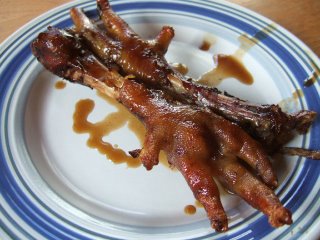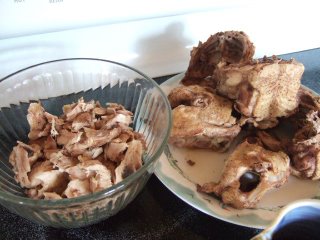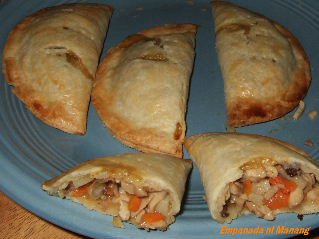Filipinos who grew up in PI are usually raised to avoid waste.
I remember when I was still a child and in those times when I could not finish my food, my parents (or aunts, or yaya) would often go on guilt-tripping by telling me to think of those hungry children in Africa, or even the streetchildren in PI roaming the streets and scavenging for food, and to be thankful that we had something to eat at least 3 x a day, and that the best way to show appreciation is to not waste any...So I would gulp down the last spoonful of food on my plate although I was almost turning green from having had too much.
This kind of upbringing is reflected on the advertisement of Max's Fried Chicken that says "Sarap to the bones" (which is kinda the equivalent of A1 Steak Sauce's commercial where the consumer could not let the last drop be wasted). It is very usual for us Filipinos to scrape the meat completely off the bone.
 This is also the reason why our street foods in the Philippines showcase not only meaty grilled/deep fried chicken thighs/legs, or pork, but also the isaw (both chicken and pork), adidas, cubed pork blood, chicken neck, deep fried small intestines with the intact mesentery (chicharong bulaklak), chicken head, pig ears, etc. And when we do cook fish, whether fried, steamed, grilled, boiled, or smoked, we do include the head. (Photo courtesy of Victor Paul Borg of fiery-foods.com)
This is also the reason why our street foods in the Philippines showcase not only meaty grilled/deep fried chicken thighs/legs, or pork, but also the isaw (both chicken and pork), adidas, cubed pork blood, chicken neck, deep fried small intestines with the intact mesentery (chicharong bulaklak), chicken head, pig ears, etc. And when we do cook fish, whether fried, steamed, grilled, boiled, or smoked, we do include the head. (Photo courtesy of Victor Paul Borg of fiery-foods.com)A lot of Westerners shake their head that we eat such things, sometimes grossed out, but often feel sorry that we "had to make the most" of what we had because we "did not have plenty." What they do not realize is that, many of us have a choice and can afford to get the meaty parts instead of the "useless" parts. However, while we do have that choice, we have also developed the taste for these exotic dishes that we cook using the "rejects" (by the foreigners) and that we actually look for them. Now that a lot of us are scattered all over the world, we often would spend the money to get such items as frozen pork blood, pig head, etc., if at all we had access to these.
I consider myself lucky in that respect. Because while I am already here in rural Maine, my in-laws like raising chickens, pigs, and cattle (they find the grocery-sold hard to take). Every year we have one cow slaughtered, they have several chickens, and at least one pig chopped up and frozen immediately for a whole year's supply (I would like to learn from them in the near future how to raise these animals). After knowing what I was "willing" to take home what they can't consume yet do not wan't to waste as much as possible, I am now the regular recipient of such parts, so that I get the chance to try cooking exotic delicacies (which I previously just bought when I was still living in PI), and I am also coming up with new westernized dishes using them.
So, let me re-phrase what to me defines being a Filipino when it comes to food: Nothing is wasted.
While Market Manila shows the items typically found in a Filipino pantry, I am showing here what I tend to stock in my freezer to make use of these "rejects" (rejected by the typical Westerner), and the dishes I come up with.
Due to my SIL's recent slaughtering of chickens for a whole year's supply, I now have these parts ( I did not ask for the intestines not because of embarrassment but because I dreaded the work that would be needed to prepare them, when it was most likely only me who will enjoy them):

 chicken feet, which I slowcooked adobo+pares style until almost fall-off-the-bone tender, then broiled. I had it for lunch today, and reminded me of those times when I, as a 4th grader, would walk home with my classmate, stopped by her house to have adidas for my merienda. (I will post later about how to clean them, for the benefit of those who have access to them but do not know how to prepare them.)
chicken feet, which I slowcooked adobo+pares style until almost fall-off-the-bone tender, then broiled. I had it for lunch today, and reminded me of those times when I, as a 4th grader, would walk home with my classmate, stopped by her house to have adidas for my merienda. (I will post later about how to clean them, for the benefit of those who have access to them but do not know how to prepare them.) I froze these chicken skin (labeled chicharon, uncooked still), chicken neck (labeled leeg), and chicken a** (labeled puwet; I will grill these on skewers; they're my fave part in a roasted chicken, but I managed to keep it a secret from my husband up to now...shhh!). I had to label them in Tagalog so as not to gross out my husband in case he happens to raid the freezer for an ice cream.
I froze these chicken skin (labeled chicharon, uncooked still), chicken neck (labeled leeg), and chicken a** (labeled puwet; I will grill these on skewers; they're my fave part in a roasted chicken, but I managed to keep it a secret from my husband up to now...shhh!). I had to label them in Tagalog so as not to gross out my husband in case he happens to raid the freezer for an ice cream.
 chicken backs (from those chickens my SIL cut up). I have boiled some of them here (seasoned with garlic, peppercorn, salt and pepper). I removed the meat that clung to the bones (in a bowl here, shredded) then placed the bones back to the pot to continue boiling for at least an hour to extract the flavor.
chicken backs (from those chickens my SIL cut up). I have boiled some of them here (seasoned with garlic, peppercorn, salt and pepper). I removed the meat that clung to the bones (in a bowl here, shredded) then placed the bones back to the pot to continue boiling for at least an hour to extract the flavor.I can do a lot with the shredded meat and the stock. The following are things that I have made before, and again and again, not only today (for sauteeing as instructed below, use 1-2 tbsp oil, 2 cloves minced garlic, 1 medium sliced onion, 1 sliced medium tomato):
 empanada
empanada chicken sopas (I sometimes use leftover Mac & Cheese instead of shell macaroni because my husband and stepdaughter love M&C, so we tend to have leftover very often, but it seldom gets eaten when just reheated in the microwave, so this is one creative way to make use of that). Sautee garlic, onion, tomatoes and chicken shreds, add stock (4 cups), let boil, add the pasta (1/2 cup), add carrots, then add chinese cabbage. Season with salt and pepper. Turn off heat. Add some cream and stir.
chicken sopas (I sometimes use leftover Mac & Cheese instead of shell macaroni because my husband and stepdaughter love M&C, so we tend to have leftover very often, but it seldom gets eaten when just reheated in the microwave, so this is one creative way to make use of that). Sautee garlic, onion, tomatoes and chicken shreds, add stock (4 cups), let boil, add the pasta (1/2 cup), add carrots, then add chinese cabbage. Season with salt and pepper. Turn off heat. Add some cream and stir. chicken sotanghon soup. Boil the stock with some chicken pieces. Add enough sotanghon (a small package for 2 quarts of broth) and cook until soft (about 2 minutes), add spinach (I used to use bittermelon leaves or thin slices of the fruit when I was in PI). Consume right away lest the noodles will soak up the soup.
chicken sotanghon soup. Boil the stock with some chicken pieces. Add enough sotanghon (a small package for 2 quarts of broth) and cook until soft (about 2 minutes), add spinach (I used to use bittermelon leaves or thin slices of the fruit when I was in PI). Consume right away lest the noodles will soak up the soup. pancit sotanghon. Sautee, in order, garlic, onion, tomatoes, chicken pieces, carrots, pea pods, and bell peppers, add stock and let boil. Season with salt, pepper, and soy sauce. Add shrimp as desired and cook for 1 minute followed by greens to blanch (regular cabbage or chinese cabbage), dish out the ingredients and add sotanghon to the simmering stock (approximately 1 big package to 2 quarts broth). Let cook until tender (about 2 minutes). Place noodles onto a dish, drizzle with sesame oil and mix well, then top with the other ingredients. Serve with patis-mansi.
pancit sotanghon. Sautee, in order, garlic, onion, tomatoes, chicken pieces, carrots, pea pods, and bell peppers, add stock and let boil. Season with salt, pepper, and soy sauce. Add shrimp as desired and cook for 1 minute followed by greens to blanch (regular cabbage or chinese cabbage), dish out the ingredients and add sotanghon to the simmering stock (approximately 1 big package to 2 quarts broth). Let cook until tender (about 2 minutes). Place noodles onto a dish, drizzle with sesame oil and mix well, then top with the other ingredients. Serve with patis-mansi. chicken balls (a variation of fish balls, homemade by making a batter with the finely chopped chicken meat, chopped carrots, onions, and garlic, using egg, flour, and milk, baking powder and baking soda, and seasoned with salt and pepper, then deep fried)
chicken balls (a variation of fish balls, homemade by making a batter with the finely chopped chicken meat, chopped carrots, onions, and garlic, using egg, flour, and milk, baking powder and baking soda, and seasoned with salt and pepper, then deep fried) chicken fettuccine (adaptation of an Italian dish, but enriched with veggies as shown, so I have "Filipinized" it). Cook fettuccine according to package directions and drain. Meanwhil, sautee garlic, onion, chicken pieces, and optional mushroom, corn, carrots, and peas. Add 1 tbsp flour to the oil and stir to make a paste, then add stock in thin stream to make it creamy. Add (optional) thin slices of hotdogs. Serve atop pasta.
chicken fettuccine (adaptation of an Italian dish, but enriched with veggies as shown, so I have "Filipinized" it). Cook fettuccine according to package directions and drain. Meanwhil, sautee garlic, onion, chicken pieces, and optional mushroom, corn, carrots, and peas. Add 1 tbsp flour to the oil and stir to make a paste, then add stock in thin stream to make it creamy. Add (optional) thin slices of hotdogs. Serve atop pasta. chicken dumplings (made with the same batter as chicken balls, only dropped in boiling stew of seasoned tomatoes; another adaptation). Prepare stewed tomatoes by sauteeing garlic, onion, and lots of peeled, cored, and chopped tomatoes (about 30 pieces medium, simmered then blenderized and simmered again. Add dried basil and oregano, salt and pepper to taste. Into the boiling stew, drop the batter by the teaspoon, with enough space in between. Cover and let simmer for about 5-10 minutes.)
chicken dumplings (made with the same batter as chicken balls, only dropped in boiling stew of seasoned tomatoes; another adaptation). Prepare stewed tomatoes by sauteeing garlic, onion, and lots of peeled, cored, and chopped tomatoes (about 30 pieces medium, simmered then blenderized and simmered again. Add dried basil and oregano, salt and pepper to taste. Into the boiling stew, drop the batter by the teaspoon, with enough space in between. Cover and let simmer for about 5-10 minutes.) or as quesadilla. I now use the George Foreman grill to make individual servings of quesadilla. I like using lots of mozzarella cheese and American white cheese along with chopped bell peppers and onions, sandwiched by a folded flour tortilla and heated for about 7 minutes, the topped by homemade tomato salsa.
or as quesadilla. I now use the George Foreman grill to make individual servings of quesadilla. I like using lots of mozzarella cheese and American white cheese along with chopped bell peppers and onions, sandwiched by a folded flour tortilla and heated for about 7 minutes, the topped by homemade tomato salsa.(added today, sep. 8)
 chicken mami. Boil the stock, add the mami noodles and cook for 3 minutes. Dish out the noodles, then add chicken pieces and sliced stems of chinese cabbage, let re-boil. Turn off the heat then add slices of the soft parts of the chinese cabbage and thin slices of carrots. Serve immediately.
chicken mami. Boil the stock, add the mami noodles and cook for 3 minutes. Dish out the noodles, then add chicken pieces and sliced stems of chinese cabbage, let re-boil. Turn off the heat then add slices of the soft parts of the chinese cabbage and thin slices of carrots. Serve immediately.Other uses: arroz caldo, chicken roll (sorry, no photo, but it is like making the usual dinner roll but using chicken mixed with cream of chicken soup or cream of mushroom as a filling; makes it like siopao but baked instead of steamed).
These are just some examples of the Filipino's no-waste attitude when it comes to food. I also have frozen pork blood in my kitchen, for what else but dinuguan.
Allow me to reiterate what to me defines being a Pinoy when it comes to food: The ability to come up with dishes utilizing all edible parts of the food so that NOTHING IS WASTED.

5 comments:
Excellent post, Manang, and so true! Yup, we Pinoys are "matipid" and we were raised to believe in "waste not, want not". I still remember a lecture from my mom not too long ago about not letting one single grain of rice go to waste in the sink or the trash can. In her day, rice was almost held sacred by her family. Our children would do well to hold on to these lessons. So glad to see you posting again -- and thanks for joining us for Lasang Pinoy!
Napaka-creative talaga mga Pinoy noh? :-) Nice post you have here Manang KusiNARS. :-)
gosh, that's a lot of ways to make chicken :) You are so lucky (I've mentioned this before) to have your in-laws who grow vegetables and slaughter their own meats. You are probably teaching them a thing or two about not letting 'spare parts' go to waste. Here in the south, they are very much like us Pinoys. They don't wast too much and try to eat all the parts. The only thing I haven't seen them use is the blood. Di pa nila nadiskubre ang dinuguan :)
I had to laugh at you labelling your chicken parts in Tagalog so your husband doesn't get grossed out. lol! The things we do, eh? I'm so thankful I speak another language, it's like our own secret code. I do the same when I don't want my hubby to know :P
stefoodie and ladybug,
yes that is so true about Pinoys when it comes to food. Our creativity is maximized in our effort to waste not.
jmom,
maybe you can teach them about dinuguan. :)
Wow, Manang! Nothing is wasted--so true! If I didn't finish my dinner, my parents would serve it to me for breakfast the next day! And I grew up learning to scrape the meat, even the cartilege, off the chicken drumsticks, then sometimes breaking the bone to suck the marrow out! I still pick my plate clean, and leftovers always become new dishes. I call them "pantry cleaners." I freeze my chicken backs and "extra parts" until I have enough to make stock, too. And everything is good over mung bean noodles, with actual mung beens, on tortas, in lumpia ... I definitely understand! Your recycling dishes look wonderful! Now I'm hungry. Haha!
Post a Comment